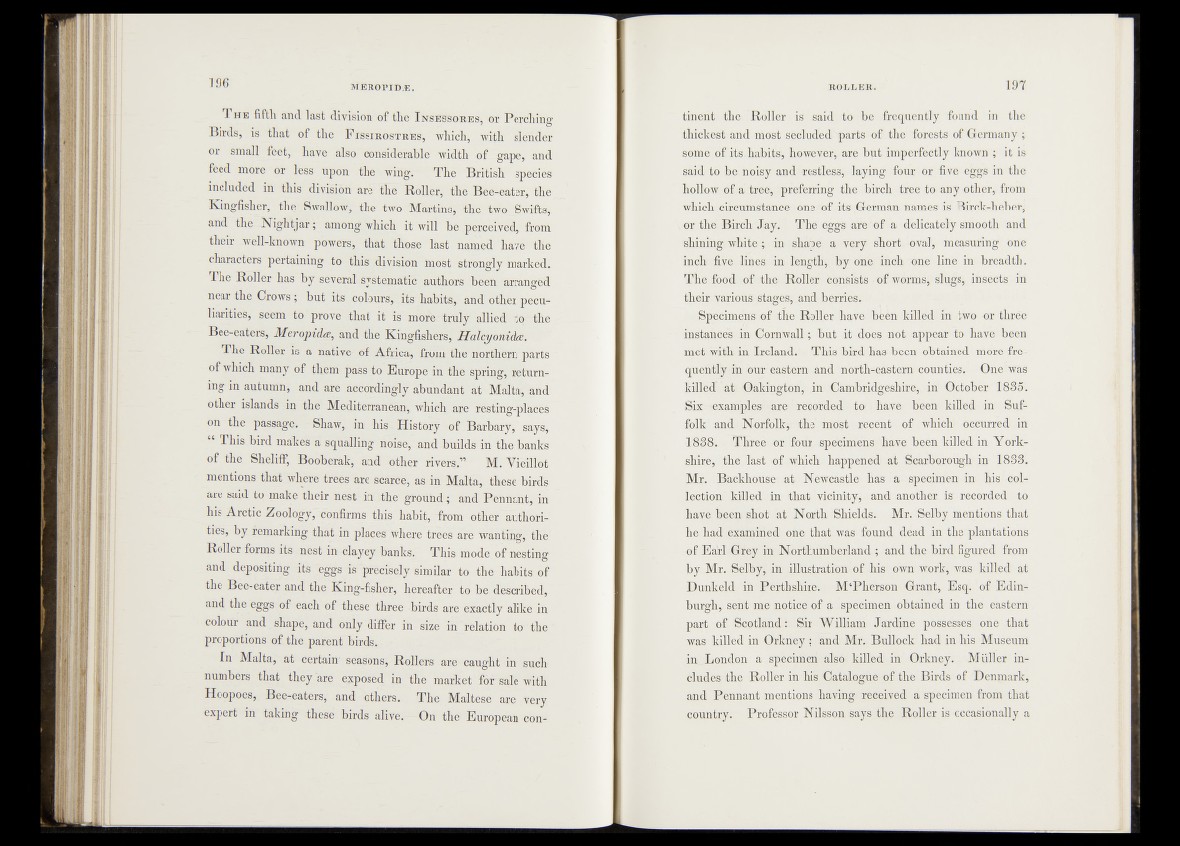
T he fifth and last division of the I n s i SBs o r e s , or Perching
Birds, is that of the F i s s i r o s t r e s , which, with slender
or small feet, have also considerable width of - gape, and
feed more or less upon the wing. The British species
included- in this division are the Roller, the Bee-eater, the.
Kingfisher, .the.Swallow, the two Martins, the two Swifts,
and the - Nightjar; among> which it will be .perceived, from
their well-known powers, that those last named havPtlie
characters pertaining to this division most strongly marked.
The Roller has by severaUsystematic authors been arranged
near the Crows ; but its colours, Jts habits, and other peculiarities,
seem to prove that it fst more' truly*1jellied toythe ,
Bee-eaters, Meropida, and the Kingfishers, Halcyonida,,
The Roller is a native-" of Africa, from the northern parts '
of which many of them pass to Europe in the spring, return-
i&g in autumn, and are accordingly abundant at Malta; and
other islands dn the Mediterranean, which are ntSsting-p'l’a'c’es
on the passage. Shaw, in his: History of Barbary, says,
“ This, bird makes a squalling nd&r,:and builds in tff^baii^
of the Sheliff, Booberak, and other rivers^’ Mi Y i l i
mentions that where trees are scaree, as in Malta, thfe&fe birds
are said to make their host in the ground; and Pennant, in
his Arctic Zoology, 'confirms this habit, from other autheri-'
tiCSy byjtemarking -that in places'“where trees are wanSSfff'the*
Roller forms its nest in clayey banks^' This m ode , of nesting
and- depositing its "eggs is precisely similar to the - habfti ofi
the Bee-eater and the King-fisher, hereafter to be described,-
and the eggs of each of these three birds are exactly alike in
-colour and shape, and only differ in size in relation to1'the '
proportions of the parent birds.
In Malta, at certain seasons, Rollers are caught in-isuch-
numbers that they, are ejposed in the market forntilll; With
Hoopoes, Bee-eaters, and others. The Maltese are very
expert in taking these birds alive. On the European continerit
the Roller is said to be frequently found in the
thickest and most secluded 'parts of the forests of Germany ;
some of its.habits, however, are but imperfectly known ; it is
said to be noisy and restless, laying four or five eggs in the
hollow, öf . a tree, preferring the birch tree to any other, from
which circumstance one of its ,German names is Birck-heber,
or the Birch Jay. The eggs are of a delicately smooth and
shining white; in shape a very short, oval, measuring one
inch five lines in length, by one inch one line in breadth.
The food of tfig Roller consists of worms, slugs, insects in
their various stages, and berries* *
Specimens of the Roller have Men killed in two or three
instances.pn Cornwall; but it does not appear ko have been
met w$th4n Ireland. This bird Has been obtained more frequently
in our eastern and north-eastern counties. One was
killed*'at Oakingtonr' in Cambridgeshire, dn October 1835.
Six^-examplesi are - recorded to - have been killed in Suffolk
and Norfolk;»"the most recent of which occurred in
1 83‘8; Three or foiir specimens ' hav^lbeen killed in Yorkshire,}’
tbd^Iast of which? happened at Scarborough in 1833.
Mr. Back,ho^& a^N-ewcastlp has a specimen in his collection!.
killed^in that vicinity, and another is recorded to
have, b^mshdfilat North .Shields. Mr. Selby mentions that
Ife had examined one that was^found dead in the plantations
&f^Eai®iGrey in Northumberland; and the bird figured from
by Mr. Selby, in illustration of his ■ own work,, was killed at
Dunkeld in Perthshire. M‘Pherson Grant; Esq. of Edinburgh,
sent me notice of a .specimen obtained in the eastern
part of Scotland i Sir William Järdine possesses one that
Was killed in Orkney ^ 'and Mr. Bullock had in his Museum
iirJLondbn ■ a specimen pteo. killed in Orkney. | Müller includes
the Roller in his Catalogue of the Birds of Denmark,
and Pennant mentions having received a specimen from that
country. Professor Nilsson says the Roller is occasionally a